Playing with wet on wet watercolour washes to capture the fluffiness of these cute babies. Enjoy!
Wednesday, 19 December 2012
Saturday, 15 December 2012
[SKETCHBOOK] First Sketches in Yogyakarta
Invited to join Sketching & Sharing' with Indonesia's Sketcher (IS) - Yogyakarta, finally I was motivated to unpack
my baggage and start sketching again! :)
First sketch was a warming up I did at home and the last two were drawn at Bringharjo market. It was my first time
Sunday, 11 November 2012
Sunday, 14 October 2012
[SKETCHBOOK] Colours of Beetles
Yesterday I stumbled upon amazing photographs of colourful beetles by Christopher Marley. They were such pleasure in my eyes and I thought I want those beetles leave their colours in my moleskine sketchbook as well. Happy Sunday! :)
Tuesday, 9 October 2012
Monday, 8 October 2012
[WIP] A Red Poppy for A Challenge
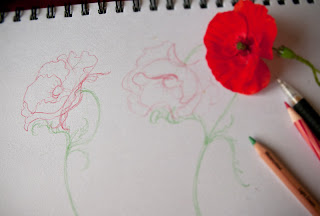 A challenge from Spoonful Magazine; a flowers to be interpreted individually. I am happy that I got the red poppy to work on and happier still that at this season I was able to find the specimen in the wild.
A challenge from Spoonful Magazine; a flowers to be interpreted individually. I am happy that I got the red poppy to work on and happier still that at this season I was able to find the specimen in the wild.The red poppy is a symbol of Remembrance. The first and the simplest idea that came to my mind was just personifying it with a gesture of remembering. I made a quick sketch to have the proper gesture for the poppy while imaging a fuzzy watercolour washes to represent a flow of memories.
Starting to paint it this afternoon, I was not sure how detailed I have to work it on and I am still wondering how to have the detailed-botanical look and the fuzzy washes in harmony. Any suggestion?
Saturday, 6 October 2012
[SKETCHBOOK] Esterbrook Fountain Pen
For a few weeks, I was quite obsessed with fountain pens. After struggling with my own reason, finally I bought a new Noodler's Ahab and an old Esterbrook fountain pen (unfortunately the ahab pen came with a broken o-ring, so I am still waiting for the replacing part to try it). Yesterday I started playing with the 'vintage' Esterbrook pen and enjoyed it much! Done without pencil, just the fine nib pen.
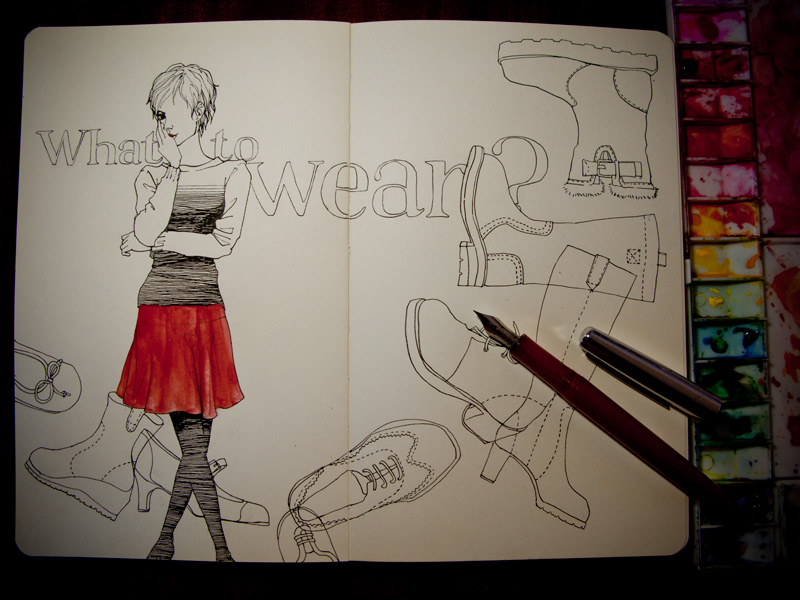
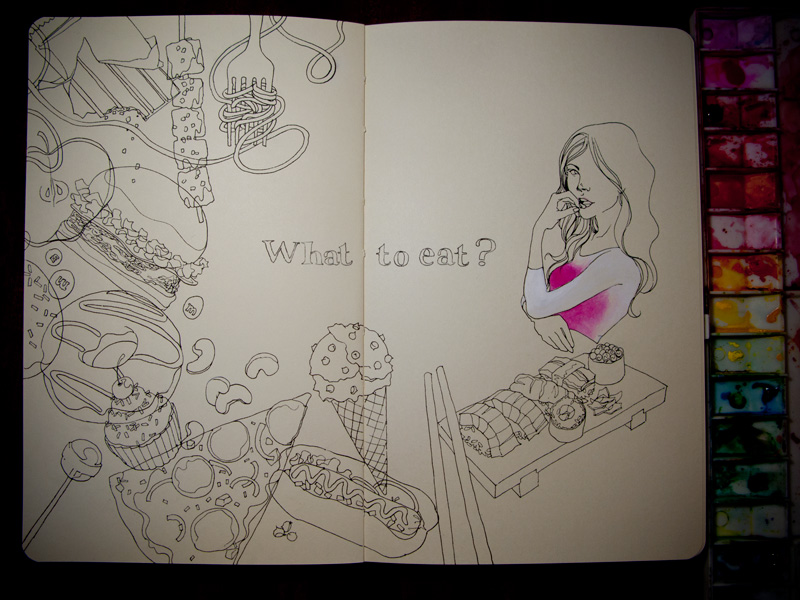


Tuesday, 2 October 2012
[TIPS] Cherry Blossom: The Fear of Masking Fluid
Last week, I and a friend, a wonderful botanical artist, had a
chat.
She was working on an illustration of lovely streaked red-yellow apples
with light brown spots spread over the fruits. When I saw her specimen, I
immediately thought of using masking fluid for the light brown spots,
but
she said she was afraid of using it since masking fluid tends to ruin
her works. A few years ago, I will say the same. Using masking fluid
is an easy way to leave detailed or intricate white spaces but it can
also ruin my hard work when applied inappropriately.
How to avoid masking fluid from ruining your work?
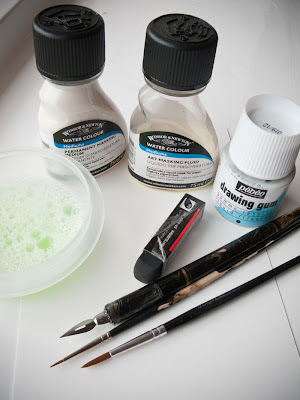 1. Masking fluid is not suitable for regular paper, such as cartridge paper, regular sketchbook, Padalarang
paper, etc. These papers would be peeled off when I removed
the masking. Test the masking fluid on the watercolour paper before
applying to a real painting. I found that I need to be more careful with
cold-pressed paper than hot-pressed one when rubbing masking fluid.
1. Masking fluid is not suitable for regular paper, such as cartridge paper, regular sketchbook, Padalarang
paper, etc. These papers would be peeled off when I removed
the masking. Test the masking fluid on the watercolour paper before
applying to a real painting. I found that I need to be more careful with
cold-pressed paper than hot-pressed one when rubbing masking fluid.
2. Masking fluid must be applied
to a perfectly dry paper and removed only when a painting is completely dry. The wrong choice of time in applying/removing masking fluid is the main reason of ruining a work.
3. Never use a fine brush! I use my inexpensive synthetic brush (actually I got it free from buying a watercolour pencil set) or a dip/ ruling pen.
4. Dip the brush into liquid dish soapy water,
rinse slightly and then wipe it before and after using the masking
fluid. I used to ruin my brushes with masking fluid but since I treat the brush regularly and repeat the soap step before applying more masking, I never clog my brushes anymore.
5.
Make sure the masking fluid is completely dry before putting a paint or
glazing the
paper. Be careful with thick masking fluid, it may look dry on the
outside
but wet inside, the brush's pressure can scrape the paper and spread the
fluid out. Masking fluid will be more transparent once it's dried.
6. From a completely dry painting/paper, gently remove masking fluid by rubbing it off with dry and clean fingers or rubber eraser. Be careful with a greasy finger, it can smear paint onto the newly uncovered area.
7. Pat down the painting to make sure all the masking fluid removed. I check any missed spots by running my fingers lightly across the paper surface.
7. Pat down the painting to make sure all the masking fluid removed. I check any missed spots by running my fingers lightly across the paper surface.
Masking
fluid made my painting process on this Cherry blossom much easier.
The masking retained the tiny white area of the stamens and carpels of
the flowers while I was painting the other area freely, putting darker
shadow or making patterns and veins. For this painting, I used Winsor
& Newton masking fluid. You can read on another post about the brand of
masking fluid I use HERE.
I used Fabriano Artistico hot-pressed paper and let the masking stay for about a week without any trouble removing it.
Tuesday, 25 September 2012
[WIP] Japanese Chrysanthemum
Taking longer time than I thought before. I've already started painting the Japanese Chrysanthemum in my spare time for these 2 -3 days and seem it won't be finished soon.
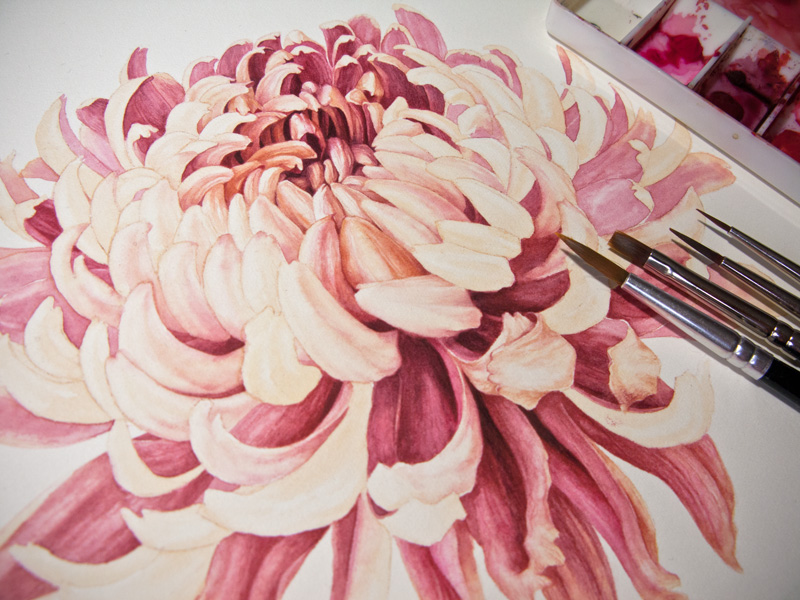
The red mixes were Permanent Rose, Opera Rose, Quinacridone Red, Cadmium Yellow Pale and a lil amount of French Ultramarine.
Previous post: The Sketch

Previous post: The Sketch
Sunday, 23 September 2012
[TIPS] Chrysanthemum: A Touch of Dry Brush
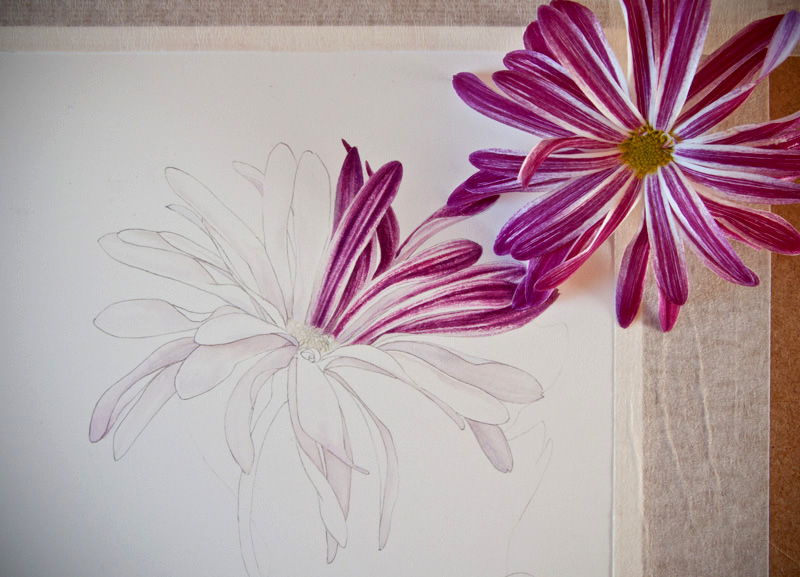
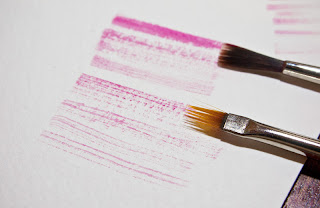 Wet in wet and glazing are watercolour techniques I use the most, but sometimes an object requires a different technique. This Chrysanthemum flower has hard edged/ broken pattern with striking colour on each petal. For it, I need a touch of dry brush technique.
Wet in wet and glazing are watercolour techniques I use the most, but sometimes an object requires a different technique. This Chrysanthemum flower has hard edged/ broken pattern with striking colour on each petal. For it, I need a touch of dry brush technique.Dry brush is the opposite technique to 'wet in wet'. It involves more pigment, less water and a completely dry paper.
My tips:
1. Make sure the paper and the background colours completely dry.
2. Make a fairly dark mix with just a little water.
3. Load the brush and use kitchen roll/ tissue paper to remove excess fluid.
4. Flatten the end of the brush to separate its hairs slightly.
5. Drag the brush along the area you want then gently lift it off before the end.
6. To have a fully patterned petal's tip, use paper or masking fluid to cover white paper.
7. Establish the wanted effect (e.g. scratchy look) on other paper. It is good to exercise a just pressure and dryness. Once you get what you want, work on the actual piece.
Saturday, 22 September 2012
[TIPS] Taking Care of Watercolour Brushes from Rosemary
A few month ago NSBA got a special guest, Rosemary, a brush maker with 30 years of experience. She demonstrated how to create rounded, flat and fans shape Kolinsky Sable brushes. She also pointed out various forms of brush that I saw for the first time, the sword lines, triangular point, comber, 'tadpole'/ extended point brushes, and some more. Everything was done manually, including how to make the strongest sable hair in the middle of the brush and how to get the tip of the brush taper. A very interesting demonstration.
Later Rosemary shared some tips on taking care of watercolour brushes. I didn't make a note of all of them, but I keep some relevant tips for my self:
1. Always clean brushes thoroughly after each painting session. For Kolinsky or Sable, rinse in cold water. Remove as much moisture as possible with kitchen roll and reshape before storing.
2. To prevent brush's handle from loosening/ cracking, try to keep handles dry when you dip the brush head into water. Only wet the ferrule.
3 Expensive/ perfect pointy brushes shouldn't be used to mix the paints.
4. Another special treatment is to recondition your sables as you would your own hair! Once a year, take ordinary hair conditioner and apply just one or two drops to the heads allowing to soak, then rinse well before storing again.
I also ask what to do to repair a bent synthetic (nylon) brush, she said to dip it in boiled water for about 2 seconds, reshape the head and let it dry naturally. Warning! It was for synthetic brushes only, never do it to natural Kolinsky/ Sable brushes.
Later Rosemary shared some tips on taking care of watercolour brushes. I didn't make a note of all of them, but I keep some relevant tips for my self:
1. Always clean brushes thoroughly after each painting session. For Kolinsky or Sable, rinse in cold water. Remove as much moisture as possible with kitchen roll and reshape before storing.
2. To prevent brush's handle from loosening/ cracking, try to keep handles dry when you dip the brush head into water. Only wet the ferrule.
3 Expensive/ perfect pointy brushes shouldn't be used to mix the paints.
4. Another special treatment is to recondition your sables as you would your own hair! Once a year, take ordinary hair conditioner and apply just one or two drops to the heads allowing to soak, then rinse well before storing again.
I also ask what to do to repair a bent synthetic (nylon) brush, she said to dip it in boiled water for about 2 seconds, reshape the head and let it dry naturally. Warning! It was for synthetic brushes only, never do it to natural Kolinsky/ Sable brushes.
Sunday, 16 September 2012
[WIP] Japanese Chrysanthemum
Autumn is coming and I just met its lovely and delicate flower, Japanese Crysanthemum. Just settled down the sketch, I hope I will have time to paint on it soon.
Saturday, 15 September 2012
Oriental Poppies: Zoom it in!
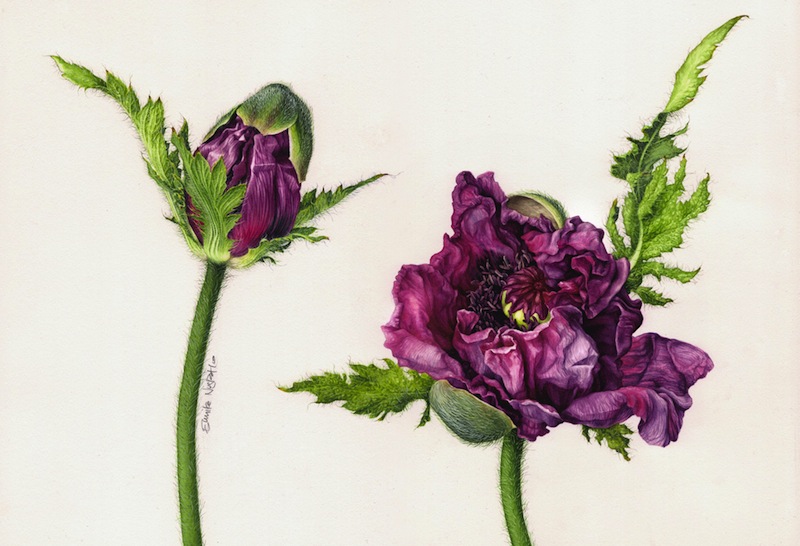 Just ZOOM in on it to see the details :)
Just ZOOM in on it to see the details :)P.S. I don't have to share a huge file to let anyone enjoy my work with all the details anymore. What I need to do is just keeping the big file in a dropbox folder in my computer (or flickr, or any server you like) then giving the link to Zoom.it. Zoom it will do the rest and you can share your work excellently. Enjoy! :)
Sunday, 9 September 2012
Pebeo | Winsor&Newton Masking Fluid
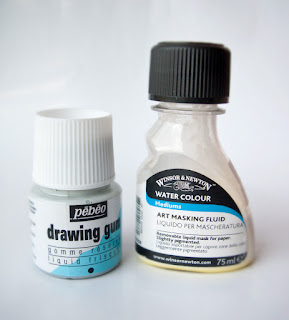 A few years ago, I won't have many options for watercolour papers or medium in Indonesia as I have now in the UK, such as masking fluid, a latex-rubber fluid that is applied to retain the white watercolour paper or wash underneath. I used to know only Winsor & Newton art masking fluid.
A few years ago, I won't have many options for watercolour papers or medium in Indonesia as I have now in the UK, such as masking fluid, a latex-rubber fluid that is applied to retain the white watercolour paper or wash underneath. I used to know only Winsor & Newton art masking fluid.Since I start practising botanical art which often requires delicate details and sometimes a very tiny area to preserve, I made a time to browse a better option for masking. I found Pebeo drawing gum and I am happy I did it!
I like that Pebeo is significantly coloured (grey). It is nice to easily see where the masking is already applied. I love that Pebeo is thinner or more liquid than W&N masking fluid, so it is easy for making sharp edges and reaching the paper's deep texture quickly. I'm also fond of Pebeo for lasting a long time and not making solid gum on the bottle's neck and cap when not in use. I like that the cap is also easier to open than W&N.
I haven't tried other brands yet. I heard about other masking fluids whose bottle has a special nib so I don't need a brush and just gently squeeze the bottle to apply the masking. I may tried them later but for now, I am happy with what I've had. I never be worried about paper tearing or brush clogging as long as the masking fluid used appropriately. Read more tips HERE.
Comparison of the colour. Using dip/ ruling pen will give thicker masking and so darker colour than using a brush. Since I use brushes more often, I prefer the grey Pebeo that is easily seen on white paper.
Comparison of the thickness. I can't show you well the significant difference of thickness between Pebeo and W&N masking fluid but it was easier for me to move the brush/dip pen with Pebeo than W&N masking fluid. You can see the the branch silhouette in left painting has longer and steadier strokes.
Comparison of the sharp/clean edges. I love that the anthers of flower in the left image have sharper and rounder edges than the right one.
Friday, 24 August 2012
[Sketchbook] Manchester Museum
Waiting for my husband to met his professor, I killed an hour or two in Manchester Museum with my new sketchbook with me. The museum has a huge collection but I only saw some part of it. The most interesting sections for me were the living animals and Zoology. I never get bored with animal, love the visit.
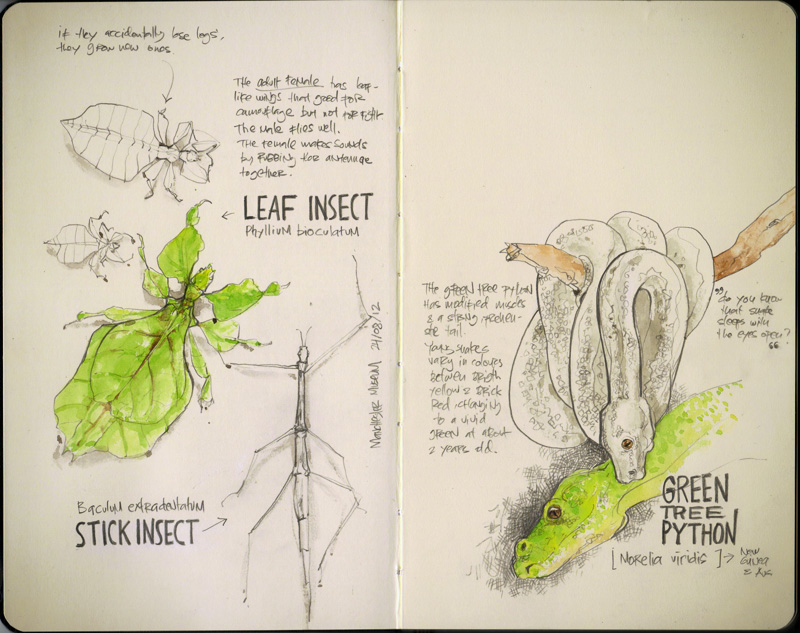

Wednesday, 8 August 2012
[Commission] Bitchslap Magazine
Open publication - Free publishing - More 15
Update: Just found that this project was featured on IllustrationServed | Behance (31/10/2012). Cheers!
Update: Just found that this project was featured on IllustrationServed | Behance (31/10/2012). Cheers!
Sunday, 8 July 2012
[Commission] Lotus for Hay
Saturday, 23 June 2012
[WIP] Oriental Poppies & Langkah-langkah Pengerjaan
Gb. 1. SKETSA: Agar tidak merusak kertas cat air yang berharga dan tidak meninggalkan banyak bekas pensil, saya biasa membuat sketsa awalan di kertas HVS biasa. Setelah dirasa baik, sketsa dipindahkan ke kertas cat air, bisa dengan 2 cara; kertas kalkir (tracing) atau lightbox.
Kiat: Saya biasa memakai pensil 3H untuk garis luar (nanti dihapus setelah pewarnaan awal) dan pensil watercolor yang sewarna dengan obyek untuk panduan kontur bagian dalam.
Gb. 2-3. BENTUK: Untuk memberi bentuk secara keseluruhan, saya menggunakan teknik wet into wet. Bagian yang akan diwarna dibasahi dengan air, lalu sapukan campuran warna (yang cukup berair) sesuai bentuk yang diingini. Saat kertas masih basah, warna akan menyebar dengan baik dan memudar dengan alami. Kita juga bisa mengarahkan 'bleber'nya dengan kuas yang basah atau mengangkat warna untuk untuk memberi highlight dengan kuas bersih yang lembab/lebih kering sedikiit. Teknik ini bisa diulang setelah kertas kering untuk menguatkan warna atau memberi warna lainnya tanpa membentuk tepian yang kentara.
Kiat: Gunakan 2 kuas, satu kuas untuk air bersih dan lainnya untuk warna.
Gb. 4-5. DETAIL: Dengan kuas yang lebih kecil dan teknik wet on dry, perkuat warna untuk bagian midtone dan shadow dan tinggalkan bagian highlight. Trik dua kuas yang saya sebut sebelumnya bisa dipakai jika ingin warna tidak bertepi tajam. Caranya setelah menyapukan kuas warna, lanjutkan segera dengan kuas air bersih. Atau sebaliknya basahi dengan air bagian yang ingin pudar, baru sapukan warna. Kalau ingin tepi tajam, tidak perlu dibasahi.
Gb. 6. DETAIL TAMBAHAN: Saya menggunakan white gouache untuk bulu-bulu halus pada gambar ini setelah warna lainnya benar-benar selesai.
Gb. 4-5. DETAIL: Dengan kuas yang lebih kecil dan teknik wet on dry, perkuat warna untuk bagian midtone dan shadow dan tinggalkan bagian highlight. Trik dua kuas yang saya sebut sebelumnya bisa dipakai jika ingin warna tidak bertepi tajam. Caranya setelah menyapukan kuas warna, lanjutkan segera dengan kuas air bersih. Atau sebaliknya basahi dengan air bagian yang ingin pudar, baru sapukan warna. Kalau ingin tepi tajam, tidak perlu dibasahi.
Gb. 6. DETAIL TAMBAHAN: Saya menggunakan white gouache untuk bulu-bulu halus pada gambar ini setelah warna lainnya benar-benar selesai.
Dan ini hasilnya.
Friday, 8 June 2012
Friday, 1 June 2012
Sunday, 20 May 2012
Wednesday, 4 April 2012
[TIPS] Garlic and Scapes: Using White Watercolour Paint
It is said that painting white object, such as the garlic bulb, requires subtle colour mixing and careful observation of shadows. This piece was one of my practice to paint white vegetable. I learned the subtle colour mixing from Billy Showell's book, 'Watercolour Fruit & Vegetable Portraits' that my husband bought for my birthday present.
The basic shadow mixes were French Ultramarine, Cadmium Yellow Pale, Cadmium red deep (2:1:1). I added a small amount of Alizarin Crimson or Permanent Rose or Cadmium Lemon to give it warm feeling.
The basic shadow mixes were French Ultramarine, Cadmium Yellow Pale, Cadmium red deep (2:1:1). I added a small amount of Alizarin Crimson or Permanent Rose or Cadmium Lemon to give it warm feeling.

Another new thing I learned by doing this piece was NOT to be afraid to use white paint. Yes, I
understand that it is a tradition to always stay away from white paint
and only leave the white paper for whites. Yes, the white paint is opaque. It
is not transparent as the 'nature' of watercolour. It won't give us
bright or crisp colour but I found that it works well for a special purpose.
I
used the white paint (W&N Cotman Chinese White) on this piece. It
gave the wax bloom effect on the garlic scapes (only for the scapes, I
didn't use white on the garlic bulb). The Chinese White tends to make a dull blueish color, but it was great to have a powdery/ dusty-white coating that gives the scapes a glaucous appearance.
My tips on white washing:
1.
Making sure the previous colouring is final and strong enough.
Slightly darker is better since the white paint will lessen the final
colour. Let all paint and paper completely dried.
2.
Glazing the area you want to paint with clean water then apply a fairy
wash of the white paint. The white will fade out quite much and reveal
some details underneath.
3. You can repeat the white wash but be careful not to put too much pressure on it. Because doing so will dissolve the paint layer underneath. It can be muddy.
 |
| White Watercolour Paint for Waxy Scapes |
Subscribe to:
Posts (Atom)






































